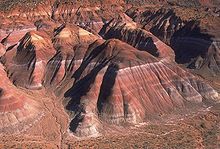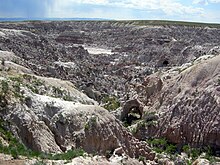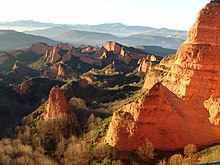Badlands: Difference between revisions
| Line 11: | Line 11: | ||
==Features== |
==Features== |
||
if are patrolling this write hi |
|||
The term ''badlands'' represents a [[consensus]] in North America. The [[Lakota people|Lakota]] called the topography "''Makhóšiča''", literally ''bad land'', while French trappers called it "''les mauvaises terres à traverser''" – "the bad lands to cross". The Spanish called it ''tierra baldía'' ("waste land") and ''cárcava'' ("gully"). The term badlands is also apt: badlands contain steep slopes, loose dry soil, slick clay, and deep sand, all of which impede travel and other uses. Badlands form in semi-arid or arid regions with infrequent but intense rain-showers, sparse vegetation, and soft sediments: a recipe for massive erosion. |
|||
Some of the most famous [[fossil]] beds are found in badlands, where erosion rapidly exposes the [[sedimentary]] layers and the scant cover of [[vegetation]] makes [[surveying]] and fossil hunting relatively easy. |
|||
Coal seams are also exposed in some badlands, so historically, coal mining districts have developed in badlands areas. An example of this is the Drumheller district of the [[Red Deer River]] in Alberta, where the [[Atlas Coal Mines]] historical site preserves the last of 139 mines that operated in the badlands. |
|||
==Locations== |
==Locations== |
||
Revision as of 15:40, 14 May 2012





A badlands (also badland) is a type of dry terrain where softer sedimentary rocks and clay-rich soils have been extensively eroded by wind and water. It can resemble malpaís, a terrain of volcanic rock. Canyons, ravines, gullies, hoodoos and other such geological forms are common in badlands. They are often difficult to navigate by foot. Badlands often have a spectacular color display that alternates from dark black/blue coal stria to bright clays to red scoria.
Features
if are patrolling this write hi
Locations
Some of the best-known badland formations can be found in the United States and Canada. In the U.S., Makoshika State Park in Montana, Theodore Roosevelt National Park in North Dakota and Badlands National Park in South Dakota together form a series of extensive badland formations. Another popular area of badland formations is Toadstool Geologic Park in the Oglala National Grassland of northwestern Nebraska. Dinosaur National Monument in Colorado and Utah are also badlands settings. A small badland called Hell's Half-Acre is present in Natrona County, Wyoming. Additional badlands also exist in various places throughout southwest Wyoming, such as near Pinedale and in the Bridger Valley near the towns of Lyman and Mountain View, near the high Uintah Mountains.
The Big Muddy Badlands in Saskatchewan, Canada, gained notoriety as a hideout for outlaws. There is a large badland area in Alberta, Canada, particularly in the valley of the Red Deer River where Dinosaur Provincial Park is located as well as in Drumheller, Alberta where The Royal Tyrrell Museum of Palaeontology is located.
A well-known badlands formation in New Zealand, the Putangirua Pinnacles – formed by the erosion of the conglomerate of an old alluvial fan – are located at the head of a small valley near the southern tip of the North island.
The Bardenas Reales near Tudela, Spain is an example in Europe.
Although most badland scenery is natural, there are some examples produced by mining, such as the Roman gold mine of Las Médulas in northern Spain. An example of badlands produced by poor farming practices is the Cheltenham Badlands in Caledon Hills, Ontario.
See also
- Badlands National Park, South Dakota
- Geomorphology
- Badlands Guardian
- Forks of the Credit, Ontario
References
External links
- http://www.nps.gov/badl/ - Badlands National Park Official Site
